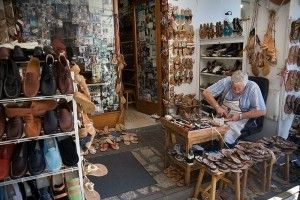Statistician like a shoemaker
Children bring from school strange home assignments, like for example a question: What is your dad’s job similar to? After several hits (a cosmonaut, Formula 1 driver, firefighter) it turns out that the work performed by a statistician is very much similar to the work of a shoemaker. Why?

I don’t mean that a shoemaker drinks a lot and swears when something doesn’t work out (read: swears a lot). These are stereotypes. I mean that we can identify similar subgroups within both craft guilds.
A craftsman – seller. He gets a machine for making shoes (or ready-made shoes) and he sells them. He knows a bit about shoes, for example, that there is a right and left shoe and that if the client put them on wrongly, he will not like it. He can show the shoes from a better perspective and when he lacks the right size, he claims that after some period of wear the shoes will become looser or they will shrink etc. Who cares that the method assumes normality while the data are as skew as the Tower of Pisa? Surely, it is very robust and the impact of unrealized assumptions is marginal. Too little observation and the power of the test barely has the level of significance? And what of it? It rains very rarely in this area so the shoe will last for long.
A craftsman – artist. He knows best what his client needs. The client brought a beautiful rabbit skin and wanted high winter boots, but the artist made a beautiful cap. No, please, believe me, such data can serve as a source for such analyses. No, you don’t need a test for two means. In this case PCA will serve ideally. You will be satisfied and the cap looks fantastic.
A craftsman – theoretician. He does not make shoes but he examines what would happen to the shoes in some untypical or impossible scenarios. For example, how would the shoe’s lifespan change if one run with the speed coming close to infinity, or if one jumped on the surface of Mars, or if one had not two but 314 feet?
A craftsman – handyman. Clients come to him with shoes with holes in the soles and he patches them up, sews them up. He makes up medians or add some Wilcoxon test results. Maybe the final result is a little scary for people with taste but the clients are able to go home and do not have to look for a skin for a new pair of shoes.
A craftsman – future man. He notices that people’ve got bored with shoes and he is looking for new and more attractive niches. He does shoe science, is interested only in large sizes of shoes because such shoes entail technological challenges. The wall of his workshop is decorated with a black belt in six shoe sigma and he commutes riding an elephant.
In general, they make such a funny group which meets from time to time in order to exchange notes and decide which skin makes nicer, more comfortable, more stable or easier to make shoes.
Have I omitted some subgroups of this guild?



